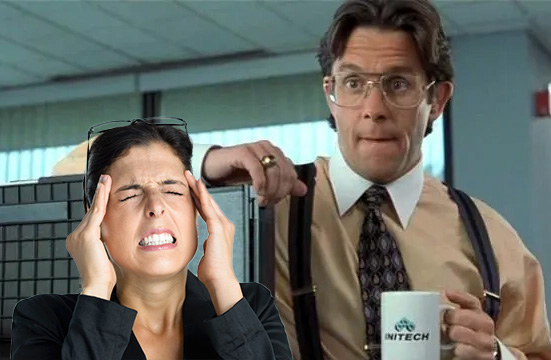Understanding Migraines
Migraine headaches are complex neurological events that go beyond the scope of typical headaches. As you’ve likely experienced, the intense pain of a migraine mixes very poorly with being able to function at work. They can be triggered by a variety of work-related environmental triggers, including your passive aggressive boss standing at your cubicle.
Migraines often come with debilitating pain and can be accompanied by symptoms such as nausea, vomiting, and an increased sensitivity to light, sound, or even certain smells. A migraine episode can last from a few hours to several days, significantly impacting one’s ability to function normally.
Migraines may follow a progression through 4 distinct stages: the prodrome, aura, headache, and postdrome. The prodrome phase can start up to 24 hours before the headache itself, marked by subtle symptoms like mood changes, brain fog, food cravings, dizziness, neck pain, sensitivity to light, or frequent yawning. The aura phase, which not everyone experiences (about 30%), may involve visual disturbances or other sensory changes. The headache phase is usually characterized by intense, throbbing pain, often on one side of the head. Finally, the postdrome phase can leave you feeling drained and fatigued, even after the pain subsides. Headache is by far the most disruptive to a person’s workday, but any one of these phases can be equally disabling for different people.
It’s essential to recognize that migraines are a chronic condition requiring comprehensive management strategies. Unlike occasional headaches, they involve the nervous system and can be influenced by various internal and external factors. This complexity means that effective migraine management often necessitates a multifaceted approach. When migraines are disrupting your job and ability to do your work duties, this is an absolute necessity. Medical consultation is crucial for proper diagnosis and to develop a tailored treatment plan.
Understanding the underlying nature and specific symptoms of migraines is the cornerstone of effective management. Awareness and proactive measures can significantly improve your quality of life, making it possible to navigate through your daily responsibilities at both home and work with more ease. Recognizing early signs and symptoms can help in implementing timely interventions, potentially reducing the severity and duration of an episode. In this blog we will discuss how to manage migraines in the work environment.
Identifying Triggers
Recognizing what sets off your migraines is essential for effective management. Stress, excess computer screen time, bright or florescent lights, strong smells, missing meals, dehydration, and loud noises are among the most common migraine triggers in the work environment. With your boss breathing down your neck, and your coworker Jane’s highly potent perfume wafting over to your cubicle, you’ve probably gotten good at predicting a migraine.
To accurately identify these triggers, maintaining a detailed migraine diary can be incredibly helpful. Note down what you eat, when you eat, your stress levels, environmental factors, and any other variables that might influence the onset of a migraine. Once you have identified migraine triggers, you can develop strategies to minimize your exposure.
It’s also crucial to communicate with your employer about your triggers and necessary accommodations. They can assist in modifying your workspace to better suit your needs, thereby reducing the likelihood of migraine episodes. Through these proactive measures, you can create a more migraine-friendly work environment and improve your overall well-being.
Creating a Migraine-Friendly Workspace
To create a migraine-friendly workspace, consider making several modifications to reduce triggers and enhance comfort.
Adjusting the lighting is crucial; use desk lamps with adjustable brightness or natural light bulbs to minimize glare and avoid florescent lighting. Installing blinds or curtains can help control sunlight, and blue light-blocking screen protectors can reduce strain from computer monitors. Wearing a good brand of migraine glasses such as Avulux which include blue light-blocking ability, in addition to other migraine-inducing wavelengths such as red and amber.
Loud noises can often be mitigated by using noise-canceling headphones. If your office is noisy, you might also explore relocating to a quieter area if possible.
Maintaining good posture is important. Ergonomic furniture, such as chairs with proper lumbar support and adjustable desks, can reduce physical strain that might contribute to migraine symptoms. Position your computer monitor at eye level to avoid neck strain, which can aggravate migraines. Take advantage of ergonomic tools, such as keyboard trays and footrests, to support a comfortable and healthy workspace.
Personalize your workspace with items that promote a calming atmosphere. This could include plants, which improve air quality, or diffusers with mild, non-triggering essential oils to help maintain a relaxing environment. Green light therapy can also be a good consideration to add in your work space.
It’s also vital to keep necessary supplies at your desk for immediate relief. An ice pack, over-the-counter medications (approved by your healthcare provider) or other quick acting abortive treatment, and water can be lifesavers when a migraine strikes. This preparedness allows you to act quickly, potentially reducing the severity and duration of an episode.
By optimizing your work environment, you may regain workdays previously lost to migraines, as participants have gained an average of 10.8 working days a year that were previously lost due to migraine.
Creating a workspace tailored to your needs can make a significant difference in managing migraines, leading to improved productivity and well-being.
Nutrition and Hydration
Nutrition and hydration are crucial aspects of managing migraines effectively. Certain foods can act as triggers for migraine episodes, making dietary awareness essential. Processed foods, aged cheeses, and foods high in additives like MSG are common culprits. On the other hand, incorporating fresh, whole foods such as fruits, vegetables, lean proteins, and whole grains can help in maintaining a balanced diet that supports overall well-being.
Monitoring your diet closely and noting any patterns in your migraine diary can aid in identifying specific food triggers. For instance, some individuals find that caffeine, while providing temporary relief, can lead to rebound headaches if consumed excessively. Moderation and consistency are key when it comes to dietary habits. If certain foods are culprits, try adjusting your diet to exclude these items and observe any changes in your migraine frequency or severity. For example, if pepperoni is a trigger, perhaps skipping that “employee appreciation” pizza on Friday might be a wise choice.
Timing of meals can also influence migraine attacks. So if you notice that a migraine is triggered when you miss meals or don’t eat on time, make sure to adjust your daily work routine to allow for eating on time.
Hydration plays an equally important role in migraine management. Keeping hydrated to avoid dehydration headaches is important because dehydration is a very common trigger for migraines. Dehydration is a well-known trigger that can be easily avoided by drinking water consistently throughout the day. Aim for at least eight glasses of water daily, and more if you’re engaging in physical activities or spending time in a hot or dry environment. In addition to water, incorporating hydrating foods like cucumbers, watermelon, and oranges can boost your hydration levels. Herbal teas and clear broths are also excellent choices, especially if you find plain water unappealing.
Keeping healthy snacks readily available at your desk can help you maintain stable blood sugar levels, which is crucial for preventing migraines. Nuts, seeds, and fresh fruit are convenient options that can provide sustained energy without causing rapid spikes in blood sugar.
Effective Stress Management
Stress is a well-known migraine trigger, making its management crucial for those prone to these headaches, regardless of the nature of your work. Your daily routine may also need lifestyle changes. If stress is a significant factor, integrating stress-relief techniques like mindfulness exercises or regular breaks into your workday can be beneficial.
At work, stress can build up quickly, so having effective strategies in place is essential. Deep breathing exercises are a straightforward yet powerful method for reducing stress. Simply taking a few minutes to inhale deeply, hold, and exhale slowly can make a significant difference. Another effective approach is mindfulness meditation, which involves focusing on the present moment without judgment. Even a short, five-minute session in a dark room can help clear your mind and reduce tension.
Incorporating yoga into your daily routine can also be beneficial. Yoga combines physical postures, breathing exercises, and meditation to help lower stress levels. If you’re unable to commit to a full session, even a few simple stretches at your desk can alleviate tension in your body and mind. Regular exercise before or after your work day can also lessen the frequency of severe migraines and/or the severity of attacks.
Regular breaks are another essential tool for stress management. Stepping away from your workspace for a short walk, a quick stretch, or even a few moments of silence can help reset your mind and prevent stress from building up. These breaks are particularly effective when they include a change of scenery or a bit of physical activity.
Time management is another key component in reducing work-related stress. Organizing your tasks, prioritizing them, and setting realistic deadlines can prevent the overwhelming feeling that often triggers migraines. Tools like planners or digital apps can help you keep track of your responsibilities and manage your workload more effectively.
Maintaining open communication with your colleagues and supervisors can also alleviate stress through the creation of a more supportive environment. Expressing your concerns and seeking support can make your work environment more accommodating, helping you manage both your stress and migraine symptoms more effectively.
Utilizing Technology for Migraine Relief at Work
In today’s digital age, technology offers numerous tools to aid in managing migraines effectively. Several apps can help you track your migraines, identify potential triggers, and monitor your progress over time. These apps often allow you to log symptoms, medications, and environmental factors, making it easier to spot patterns and manage your condition proactively.
Wearable devices have also made significant strides in providing relief for migraine sufferers. Some neuromodulation devices such as Nerivio or Cefaly deliver gentle nerve stimulation, which can help alleviate pain during an attack. These devices are designed to be discreet and can be worn throughout the day, providing continuous support without disrupting your workflow.
Biofeedback devices are another technological advancement worth considering. These gadgets teach you how to control physiological functions such as heart rate, muscle tension, and skin temperature, which can help manage stress—a common migraine trigger. By gaining better control over these bodily responses, you can potentially reduce the frequency and severity of your migraine episodes.
Virtual reality (VR) and augmented reality (AR) technologies are also emerging as therapeutic tools. These platforms can offer guided relaxation exercises and stress-relief programs that may help mitigate migraine symptoms. For instance, some VR apps provide immersive environments that promote mindfulness and relaxation, helping you manage stress levels more effectively.
How to Get Rid of a Migraine at Work
When a migraine strikes at work, immediate action can help alleviate symptoms and minimize disruption. Having an effective abortive (acute) migraine treatment such as a triptan or gepant is very important. The goal of an abortive is to quickly eliminate the migraine and maintain/restore function so you are not having to leave work and have your day disrupted. However, it should also not give side effects such as drowsiness, because that would also be disruptive to your ability to function at work. So it is crucial to find a good abortive treatment with your doctor that not only works fast, but also does not cause disruptive side effects such as drowsiness.
If migraines are disrupting your work days frequently enough (such as 4 or more migraines per month), then a migraine preventative treatment should be considered. Preventatives help to shield your nervous system from a migraine trigger, such as that perfume 4 cubicles down, being able to trigger a migraine. They also make the attack less severe if it does still break through.
Keep an ice pack or migraine cap in your workspace to apply to your head or neck for quick relief. Using over-the-counter medication, approved by your healthcare provider, can also be effective in reducing migraine pain quickly. Understanding that employed migraine sufferers lose an estimated 30.2 workdays per year due to migraines underscores the importance of having strategies to address them promptly and minimize workday disruptions.
Taking a brief break in a dark, quiet room can significantly reduce migraine symptoms. If such a space is unavailable, consider using a sleep mask and noise-canceling headphones to create a more controlled environment. Hydrating by drinking plenty of water is crucial, as dehydration can exacerbate migraine symptoms.
Using essential oils, such as peppermint or lavender, may offer relief. A small bottle at your desk can be handy for quick application to your temples or wrists. If you have a migraine-relief cap or wearable neuromodulation nerve stimulation device, consider using it during an episode for added relief.
Practicing stress-relief techniques, like deep breathing exercises or mindfulness meditation, can also be effective. Even a few minutes of these activities can help reduce the intensity of a migraine.
Lastly, make sure your workstation is ergonomically sound. Proper posture and reducing screen glare can prevent additional strain that could worsen your migraine. By having these strategies in place, you can better manage your migraines and maintain your productivity at work.
Communicating with Employers
Effective communication with your employer is crucial for managing migraines at work. Initiating a conversation with your manager or HR about your condition can help in securing reasonable accommodations that make your workspace more conducive to managing your symptoms. Begin by explaining the nature of migraines and how they impact your productivity and overall well-being.
Discuss specific adjustments that could be beneficial, such as flexible work hours, the ability to take breaks when needed, or modifications to your workspace to reduce triggers. For instance, if bright lights or loud noises are significant triggers, you might request a desk lamp with adjustable brightness or noise-canceling headphones. If possible, a quieter workspace could also be helpful.
Employers are often willing to accommodate reasonable requests, especially when they understand that these adjustments can lead to improved productivity and reduced absenteeism. Providing documentation from your healthcare provider can also support your request and offer a clearer understanding of your needs.
It’s also beneficial to establish a plan for managing migraines during work hours. Discuss with your employer the possibility of having a designated quiet space to retreat to when a migraine strikes or the option to work from home if necessary.
By maintaining open and honest communication, you can create a supportive work environment that helps manage your migraines effectively, benefiting both your health and your professional performance. Having an FMLA (Family Medical Leave Act) form on file with your employer (filled out by your doctor) helps to protect you from penalties from missed work days due to medical conditions such as migraine attacks. This is important for not only episodic migraine, but especially for chronic migraine.
Conclusions
Migraine is a very disruptive neurological disorder in all aspects of life including home, family, social, and work. However, with the right knowledge of identifying and avoiding triggers, the frequency of attacks of severe headaches can become much less intrusive into your work life. Adjusting your work environment to make it more migraine friendly will also greatly enhance your ability to perform efficiently at work without migraines derailing your ability to function at a high level. Discuss migraine abortives with your healthcare provider, and keep trying new options until you find a prescription medication that consistently works quickly without disruptive side effects such as drowsiness.
IF YOU HAVE HEADACHE, MIGRAINE, OR FACIAL PAIN AND ARE LOOKING FOR ANSWERS ON ANYTHING RELATED TO IT, A HEADACHE SPECIALIST IS HERE TO HELP, FOR FREE!
FIRST, LET’S DECIDE WHERE TO START:
IF YOU HAVE AN EXISTING HEADACHE, MIGRAINE, OR FACIAL PAIN DIAGNOSIS AND ARE LOOKING FOR THE LATEST INFORMATION, HOT TOPICS, AND TREATMENT TIPS, VISIT OUR FREE BLOG OF HOT TOPICS AND HEADACHE TIPS HERE. THIS IS WHERE I WRITE AND CONDENSE A BROAD VARIETY OF COMMON AND COMPLEX MIGRAINE AND HEADACHE RELATED TOPICS INTO THE IMPORTANT FACTS AND HIGHLIGHTS YOU NEED TO KNOW, ALONG WITH PROVIDING FIRST HAND CLINICAL EXPERIENCE FROM THE PERSPECTIVE OF A HEADACHE SPECIALIST.
IF YOU DON’T HAVE AN EXISTING HEADACHE, MIGRAINE, OR FACIAL PAIN DIAGNOSIS AND ARE LOOKING FOR POSSIBLE TYPES OF HEADACHES OR FACIAL PAINS BASED ON YOUR SYMPTOMS, USE THE FREE HEADACHE AND FACIAL PAIN SYMPTOM CHECKER TOOL DEVELOPED BY A HEADACHE SPECIALIST NEUROLOGIST HERE!
IF YOU HAVE AN EXISTING HEADACHE, MIGRAINE, OR FACIAL PAIN DIAGNOSIS AND ARE LOOKING FOR FURTHER EDUCATION AND SELF-RESEARCH ON YOUR DIAGNOSIS, VISIT OUR FREE EDUCATION CENTER HERE.



